1998 PONTIAC BONNEVILLE oil
[x] Cancel search: oilPage 271 of 395
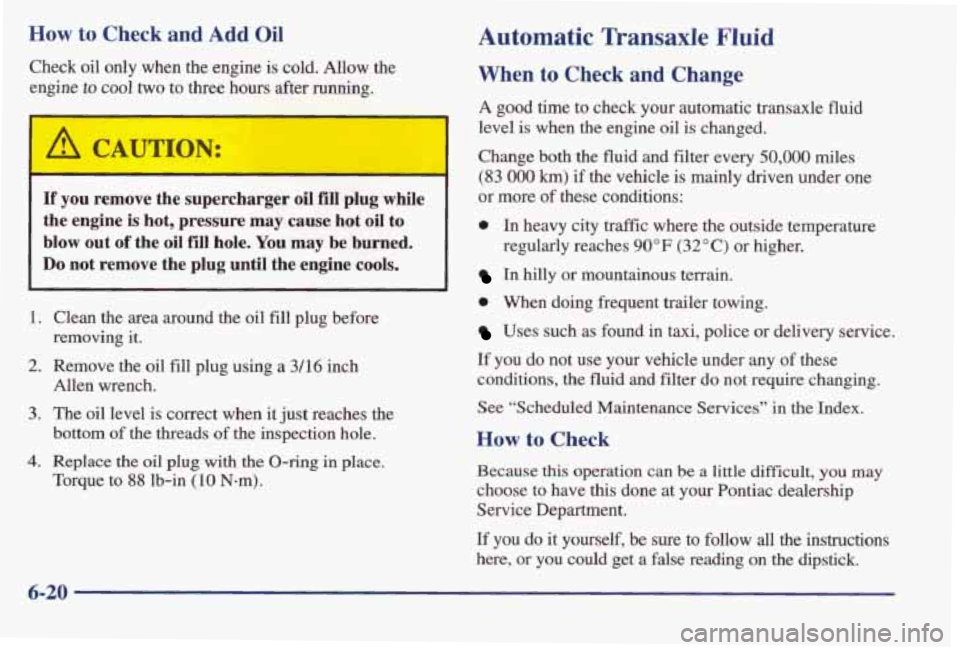
How to Check and Add Oil
Check oil only when the engine is cold. Allow the
engine
to cool two to three hours after running.
If you remove the supercharger oil €ill plug while
the engine
is hot, pressure may cause hot oil to
blow out
of the oil fill hole. You may be burned.
Do not remove the plug until the engine cools.
1. Clean the area around the oil fill plug before
2. Remove the oil fill plug using a 3/16 inch
3. The oil level is correct when it just reaches the
bottom of the threads of the inspection hole.
4. Replace the oil plug with the O-ring in place.
Torque to
88 lb-in (10 N-m).
removing it.
Allen wrench.
Automatic Transaxle Fluid
When to Check and Change
A good time to check your automatic transaxle fluid
level is when the engine oil
is changed.
Change both the fluid and filter every
50,000 miles
(83 000 km) if the vehicle is mainly driven under one
or more of these conditions:
0 In heavy city traflic where the outside temperature
regularly reaches
90°F (32°C) or higher.
In hilly or mountainous terrain.
0 When doing frequent trailer towing.
Uses such as found in taxi, police or delivery service.
If you do not use your vehicle under any of these
conditions, the fluid and filter do not require changing.
See “Scheduled Maintenance Services” in the Index.
How to Check
Because this operation can be a little difficult, you may
choose to have
this done at your Pontiac dealership
Service Department.
If you do it yourself, be sure to follow all the instructions
here, or you could get
a false reading on the dipstick.
6-20
Page 274 of 395
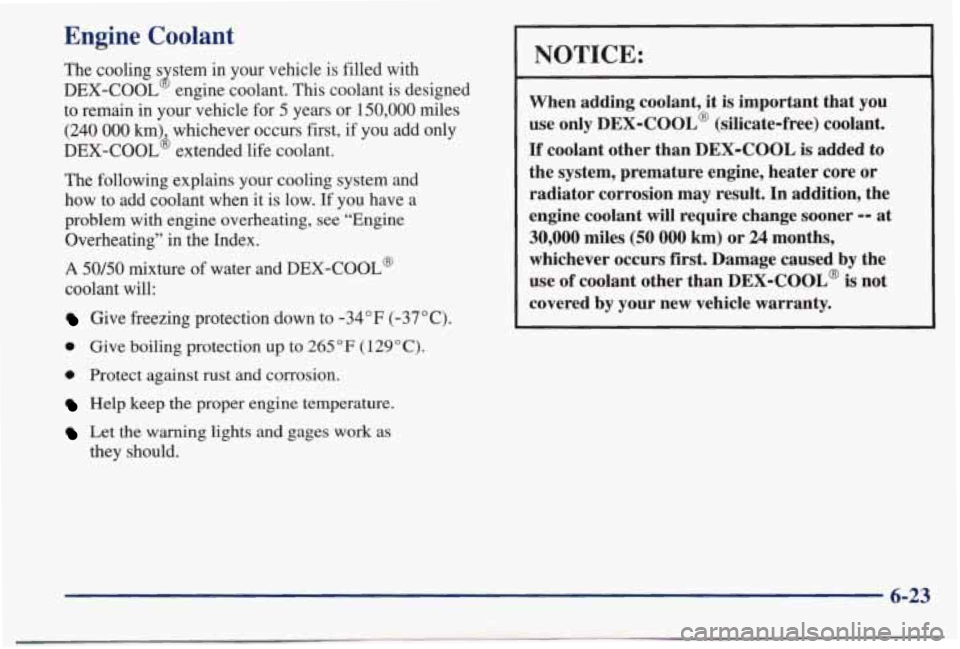
Engine Coolant
The cooling s stem in your vehicle is filled with
DEX-COOL
8 engine coolant. This coolant is designed
to remain in your vehicle for
5 years or 150,000 miles
(240 000 km) whichever occurs first, if you add only
DEX-COOL’ extended life coolant.
The following explains your cooling system and
how to add coolant when it is low. If you have a
problem with engine overheating,
see “Engine
Overheating”
in the Index.
A 50/50 mixture of water and DEX-COOL@
coolant will:
Give freezing protection down to -34°F (-37°C).
0 Give boiling protection up to 265 “F (129°C).
0 Protect against rust and corrosion.
Help keep the proper engine temperature.
Let the warning lights and gages work as
they should.
NOTICE:
When adding coolant, it is important that you
use only DEX-COOL@ (silicate-free) coolant.
If coolant other than DEX-COOL is added to
the system, premature engine, heater core or
radiator corrosion may result. In addition, the
engine coolant
will require change sooner -- at
30,000 miles (50 000 km) or 24 months,
whichever occurs first. Damage caused by the
use of coolant other than DEX-COOL@
is not
covered by your new vehicle warranty.
6-23
Page 275 of 395
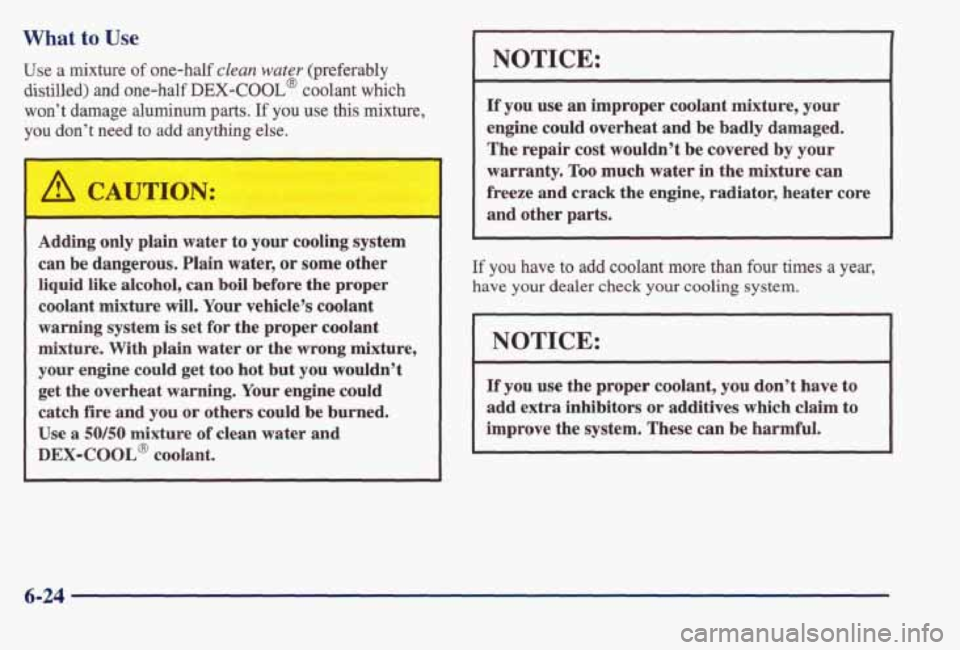
What to Use
Use a mixture of one-half clean water (preferably
distilled) and one-half DEX-COOL@ coolant which
won’t
damage aluminum parts. If you use this mixture,
you
don’t need to add anything else.
Adding only plain water to your cooling system
can be dangerous. Plain water, or some other
liquid
like alcohol, can boil before the proper
coolant mixture will. Your vehicle’s coolant
warning system
is set for the proper coolant
mixture. With plain water or the wrong mixture,
your engine could get too hot but you wouldn’t
get the overheat warning. Your engine could
catch fire and
you or others could be burned.
Use
a 50/50 mixture of clean water and
DEX-COOL@ coolant.
NOTICE:
If you use an improper coolant mixture, your
engine could overheat and be badly damaged.
The repair cost wouldn’t be covered by your
warranty. Too much water in the mixture can
freeze and crack the engine, radiator, heater core
and other parts.
If you have to add coolant more than four times a year,
have your dealer check your cooling system.
I NOTICE:
If you use the proper coolant, you don’t have to
add extra inhibitors or additives which claim to
improve the system. These can be harmful.
6-24
Page 281 of 395
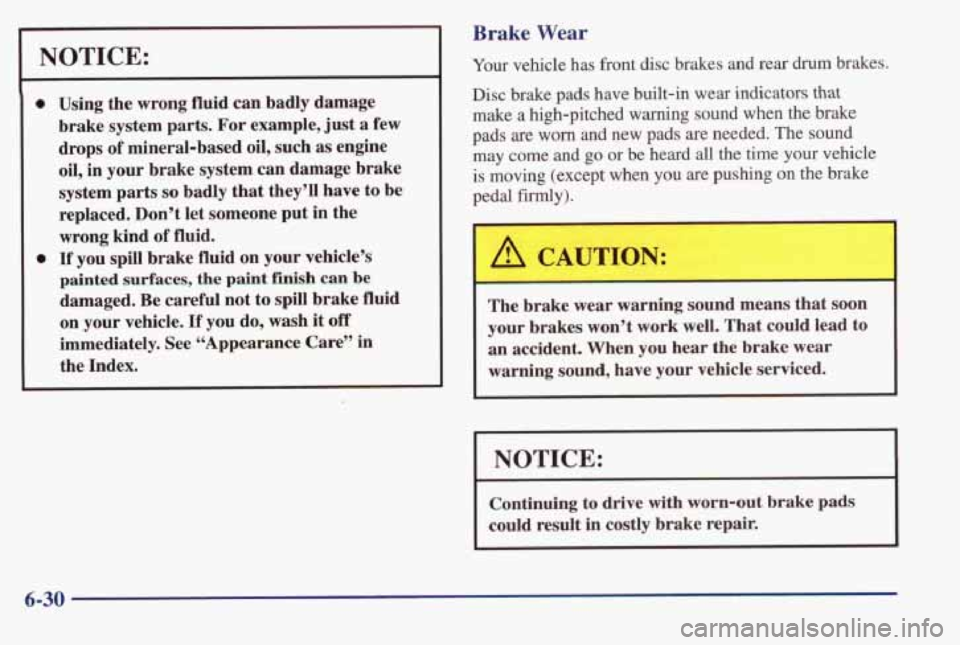
-
NOTICE:
0
0
Using the wrong fluid can badly damage
brake system parts. For example, just a few
drops
of mineral-based oil, such as engine
oil, in your brake system can damage brake
system parts
so badly that they’ll have to be
replaced. Don’t let someone put in the
wrong kind
of fluid.
If you spill brake fluid on your vehicle’s
painted surfaces, the paint finish can be
damaged. Be careful not to spill brake fluid
on your vehicle. If you do, wash it off
immediately. See “Appearance Care” in
the Index.
Brake Wear
Your vehicle has front disc brakes and rear drum brakes.
Disc brake pads have built-in wear indicators
that
make a high-pitched warning sound when the brake
pads are worn and new pads are needed. The sound
may come
and go or be heard all the time your vehicle
is moving (except when
you are pushing on the brake
pedal
firmly).
A 3
,A CAUTION:
I I
The brake wear warning sound means that soon
your brakes won’t work well. That could lead to
an accident. When you hear the brake wear
warning sound, have your vehicle serviced.
I I
I NOTICE: I ~
Continuing to drive with worn-out brake pads
could result
in costly brake repair. I
6-30
Page 300 of 395
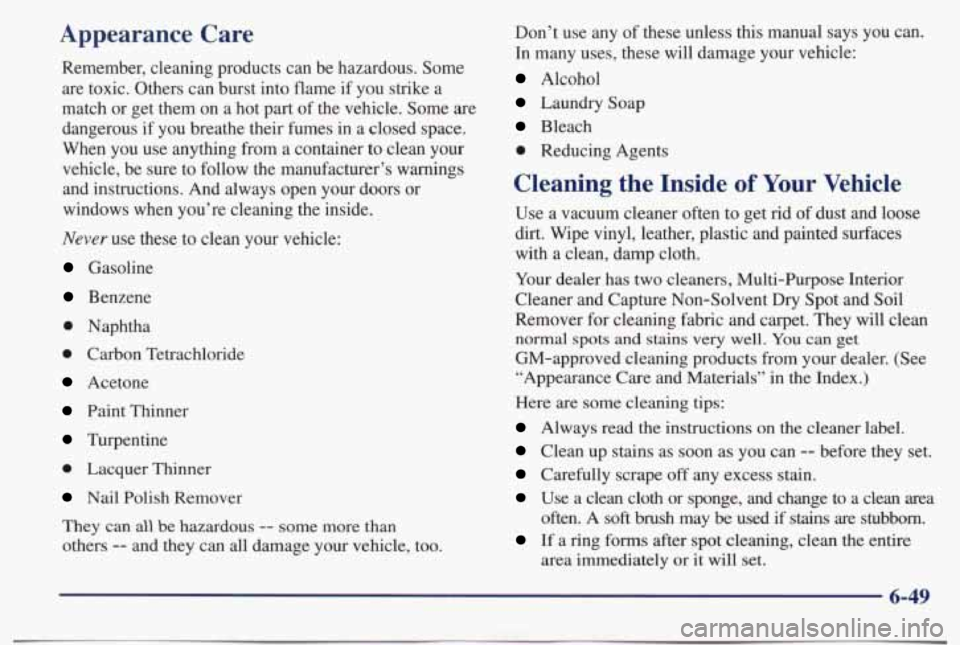
Appearance Care
Remember, cleaning products can be hazardous. Some
are toxic. Others can burst into flame if you strike a
match or get them on a hot part of the vehicle. Some are
dangerous if you breathe their fumes in a closed space.
When you use anything from a container
to clean your
vehicle, be sure to follow the manufacturer’s warnings
and instructions. And always open your doors or
windows when you’re cleaning the inside.
Never use these to clean your vehicle:
Gasoline
Benzene
0 Naphtha
0 Carbon Tetrachloride
Acetone
Paint Thinner
Turpentine
0 Lacquer Thinner
Nail Polish Remover
They can all be hazardous -- some more than
others
-- and they can all damage your vehicle, too. Don’t
use any
of these unless this manual says you can.
In many uses, these will damage your vehicle:
Alcohol
Laundry Soap
Bleach
0 Reducing Agents
Cleaning the Inside of Your Vehicle
Use a vacuum cleaner often to get rid of dust and loose
dirt. Wipe vinyl, leather, plastic and painted surfaces with a clean, damp cloth.
Your dealer has two cleaners, Multi-Purpose Interior
Cleaner and Capture Non-Solvent
Dry Spot and Soil
Remover
for cleaning fabric and carpet. They will clean
normal spots and stains very well. You can get
GM-approved cleaning products from your dealer.
(See
“Appearance Care and Materials” in the Index.)
Here
are some cleaning tips:
Always read the instructions on the cleaner label.
Clean up stains as soon as you can -- before they set.
Carefully scrape off any excess stain.
Use a clean cloth or sponge, and change to a clean area
If a ring forms after spot cleaning, clean the entire
often.
A
soft brush may be used if stains are stubborn.
area immediately
or it will set.
6-49
Page 301 of 395
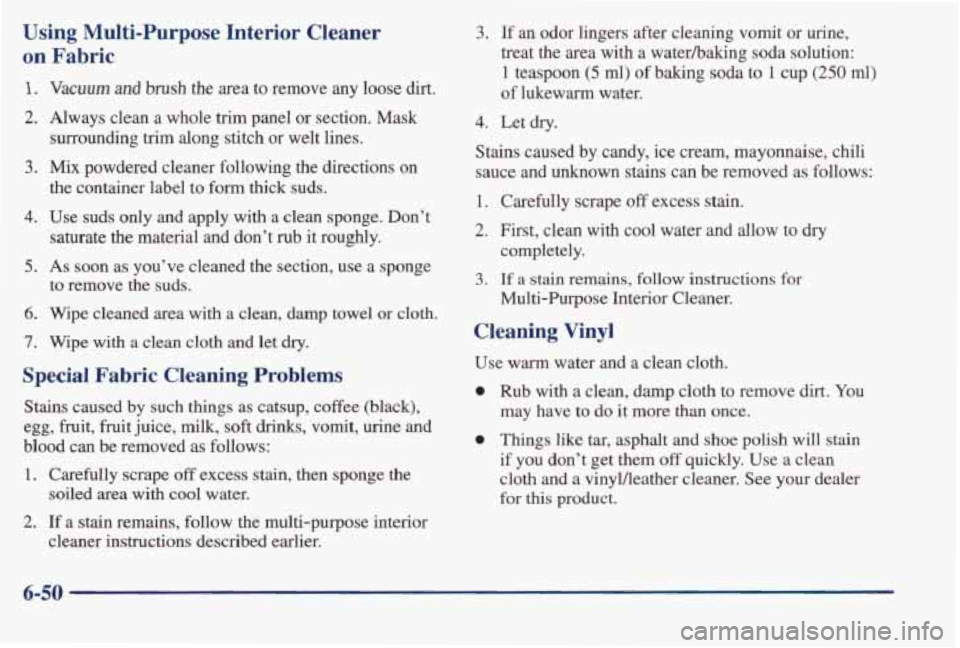
Using Multi-Purpose Interior Cleaner
on Fabric
.. .-
1.
2.
3.
4.
5.
6.
7.
Vacuum and brush the area to remove any ‘loose dirt.!
Always clean a whole trim panel or section. Mask
surrounding trim along stitch or welt lines.
Mix powdered cleaner following the directions on
the container label to form thick suds.
Use suds only and apply with a clean sponge.
Don’t
saturate the material and don’t rub it roughly.
As soon as you’ve cleaned the section, use a sponge
to remove the suds.
Wipe cleaned area with a clean, damp towel or cloth.
Wipe with a clean cloth
and let dry.
Special Fabric Cleaning Problems
Stains caused by such things as catsup, coffee (black),
egg, fruit, fruit juice, milk,
soft drinks, vomit, urine and
blood can be removed as follows:
1. Carefully scrape off excess stain, then sponge the
soiled area
with cool water.
2. If a stain remains, follow the multi-purpose interior
cleaner instructions described earlier.
3. If an odor lingers after cleaning vomit or urine,
treat the area with a waterbaking soda solution:
1 teaspoon (5 ml) of baking soda to 1 cup (250 ml)
of lukewarm water.
4. Let dry.
Stains caused by candy, ice cream, mayonnaise, chili
sauce and unknown stains can be removed as follows:
1. Carefully scrape off excess stain.
2. First, clean with cool water and allow to dry
completely.
3. If a stain remains, follow instructions for
Multi-Purpose Interior Cleaner.
Cleaning Vinyl
Use warm water and a clean cloth.
0 Rub with a clean, damp cloth to remove dirt. You
may have to do it more than once.
0 Things like tar, asphalt and shoe polish will stain
if
you don’t get them off quickly. Use a clean
cloth and
a vinyueather cleaner. See your dealer
for
this product.
6-50
Page 302 of 395
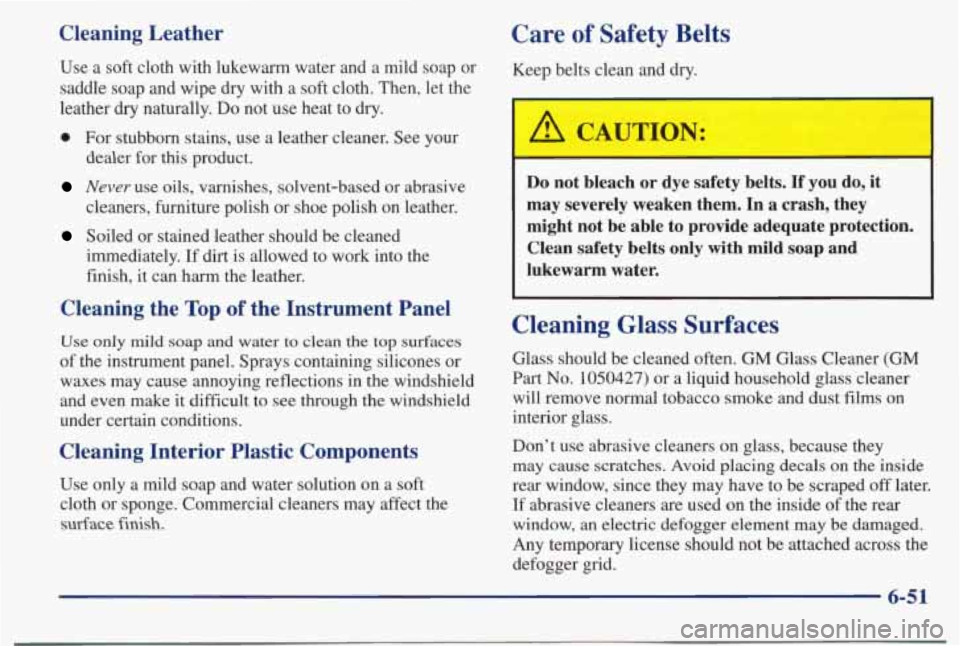
Cleaning Leather
Use a soft cloth with lukewarm water and a mild soap or
saddle soap and wipe dry with a soft cloth. Then, let the
leather
dry naturally. Do not use heat to dry.
0 For stubborn stains, use a leather cleaner. See your
Never use oils, varnishes, solvent-based or abrasive
dealer for this product.
cleaners, furniture polish
or shoe polish on leather.
Soiled or stained leather should be cleaned
immediately.
If dirt is allowed to work into the
finish, it can harm the leather.
Cleaning the Top of the Instrument Panel
Use only mild soap and water to clean the top surfaces
of the instrument panel. Sprays containing silicones or
waxes may cause annoying reflections in the windshield and even make it difficult
to sed Wough the windshield
under certain conditions. ..
Cleaning Interior Plastic Components
Use only a mild soap and water solution on a soft
cloth or sponge. Commercial cleaners may affect the
surface finish.
Care of Safety Belts
Keep belts clean and dry.
~
A CAUTION:
-
Do not bleach or dye safety belts. If you do, it
may severely weaken them. In a crash, they
might not be able to provide adequate protection. Clean safety belts only with mild
soap and
lukewarm water.
Cleaning Glass Surfaces
Glass should be cleaned often. GM Glass Cleaner (GM
Part No. 1050427) or a liquid household glass cleaner
will remove normal tobacco smoke and dust
films on
interior glass.
Don’t use abrasive cleaners on glass, because they
may cause scratches. Avoid placing decals
on the inside
rear window, since they may have to be scraped
off later.
If abrasive cleaners are used on the inside of the rear
window, an electric defogger element may be damaged.
Any temporary license should not be attached across the
defogger grid.
6-51
Page 304 of 395
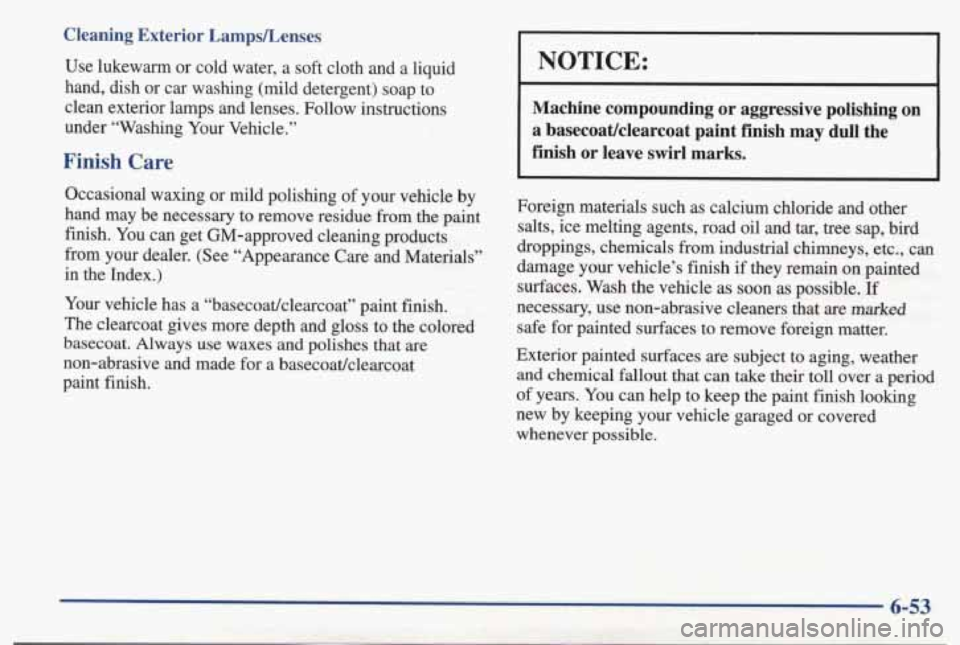
Cleaning Exterior LampsLenses
Use lukewarm or cold water, a soft cloth and a liquid
hand, dish or car washing (mild detergent) soap to
clean exterior lamps and lenses. Follow instructions
under “Washing Your Vehicle.”
Finish Care
Occasional waxing or mild polishing of your vehicle by
hand may be necessary to remove residue from the paint
finish.
You can get GM-approved cleaning products
from your dealer. (See “Appearance Care and Materials”
in the Index.)
Your vehicle has
a “basecoatlclearcoat” paint finish.
The clearcoat gives more depth and gloss to the colored
basecoat. Always use waxes
and polishes that are
non-abrasive and made for a basecoatlclearcoat
paint finish.
I NOTICE:
r
Machine compounding or aggressive polishing on
a basecoatklearcoat paint finish may dull the
finish or leave swirl
marks. -1
I I
Foreign materials such as calcium chloride and other salts, ice melting agents, road oil and tar, tree sap, bird
droppings, chemicals from industrial chimneys, etc., can
damage your vehicle’s finish if they remain on painted surfaces. Wash the vehicle
as soon as possible. If
necessary, use non-abrasive cleaners that are marked
safe for painted surfaces to remove foreign matter.
Exterior painted surfaces
are subject to aging, weather
and chemical fallout that
can take their toll over a period
of years. You can help to keep the paint finish looking
new by keeping your vehicle garaged or covered whenever possible.